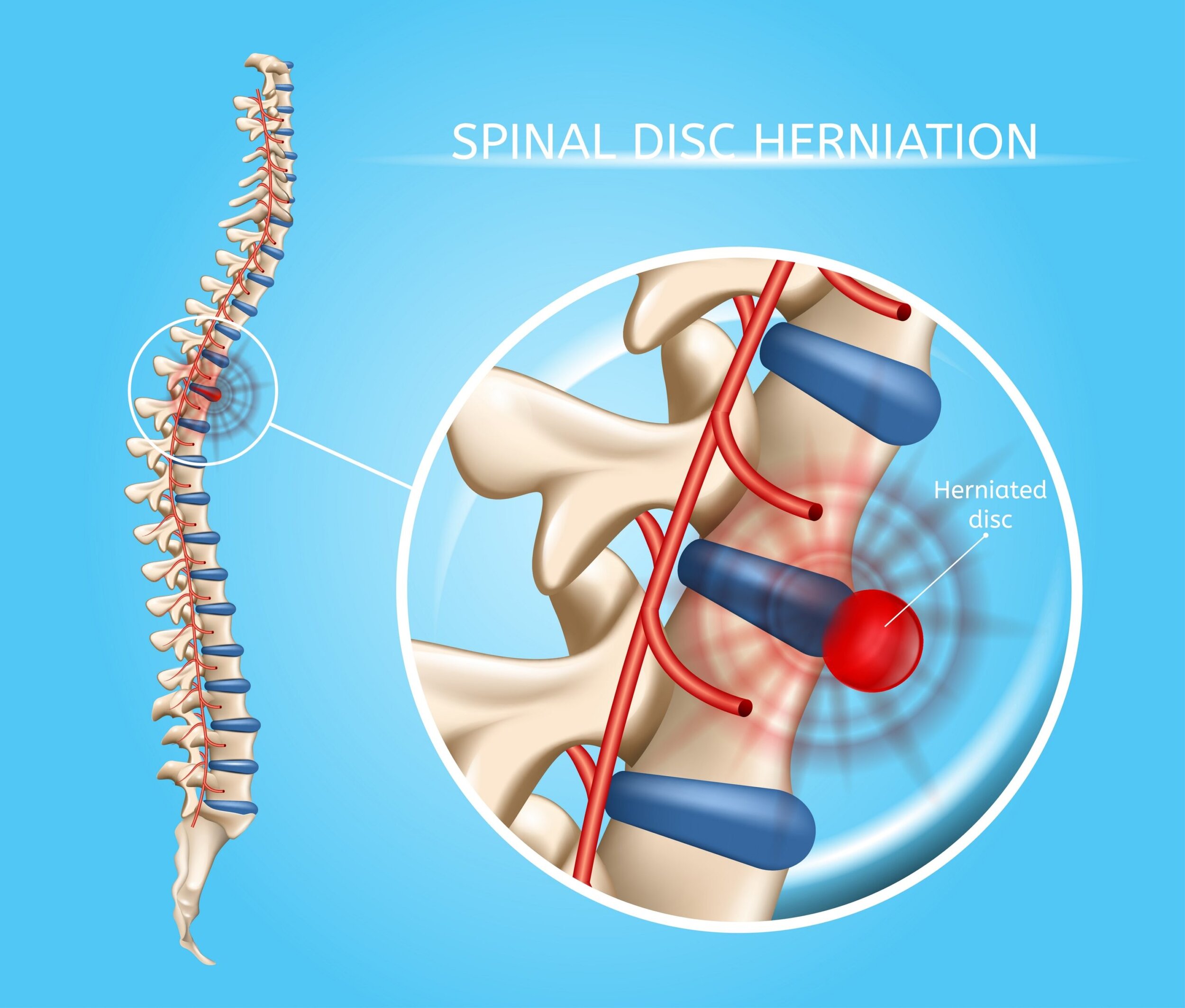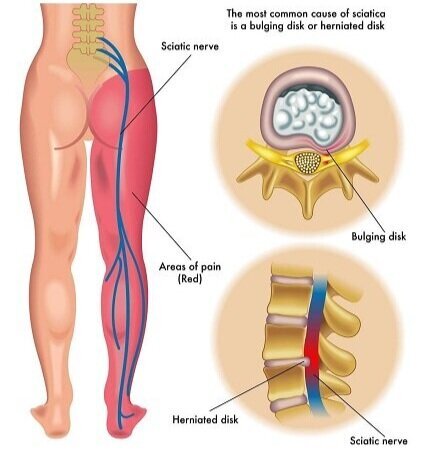Disc Herniation
The bones (vertebrae) that form the spine in the back are cushioned by discs. These discs are round, like gel pillows, with a tough, outer layer (annulus) that surrounds the nucleus. Located between each of the vertebra in the spinal column, discs act as shock absorbers for the spinal bones.
A herniated disc (also called bulged, slipped or ruptured dependent upon the level of herniation) is a fragment of the disc nucleus that is pushed out of the annulus, into the spinal canal through a tear or rupture in the annulus. Discs that become herniated usually are in an early stage of degeneration. The spinal canal has limited space, which is inadequate for the spinal nerve and the displaced herniated disc fragment. Due to this displacement, the disc presses on spinal nerves, often producing pain, which may be severe and typically radiates down the extremity associated with the compressed nerve.
Herniated discs can occur in any part of the spine. Herniated discs are more common in the lower back (lumbar spine), but also occur in the neck (cervical spine). The area in which pain is experienced, and extremity affected by radicular symptoms, depends on what part of the spine is affected.
At Aptiva Health, we offer same-day and walk-in appointments for spine injuries and conditions to evaluate, diagnose, and make the appropriate referral for additional treatment based upon your specific spine injury or condition. We treat spine injuries and conditions in our Spine, Pain Management, General Medicine, Orthopedics, and Physical Therapy departments.
Causes and Symptoms
A single excessive strain, trauma, or acute injury can cause a herniated disc. Disc material also degenerates naturally as one ages, and the ligaments that hold it in place begin to weaken. As this degeneration progresses, a relatively minor strain or twisting movement can cause a disc to rupture or herniate.
Certain individuals may be more vulnerable to disc problems and, as a result, may suffer herniated discs in several places along the spine. Research has shown that a predisposition for herniated discs may exist in families with several members affected.
Symptoms vary greatly, depending on the position of the herniated disc and the size of the herniation. If the herniated disc is not pressing on a nerve, the patient may experience a low backache or no pain at all. If it is pressing on a nerve, there may be pain, numbness or weakness in the area of the body to which the nerve travels. Typically, a herniated disc is preceded by an episode of low back pain or a long history of intermittent episodes of low back pain.
Cervical spine (neck):
Cervical radiculopathy is the symptoms of nerve compression in the neck, which may include dull or sharp pain in the neck or between the shoulder blades, pain that radiates down the arm to the hand or fingers or numbness or tingling in the shoulder or arm. The pain may increase with certain positions or movements of the neck.
Lumbar spine (lowback):
Sciatica/Radiculopathy frequently results from a herniated disc in the lower back. Pressure on one or several nerves that contribute to the sciatic nerve can cause pain, burning, tingling and numbness that radiates from the buttock into the leg and sometimes into the foot. Usually, one side (left or right) is affected. This pain often is described as sharp and electric shock-like. It may be more severe with standing, walking or sitting. Straightening the leg on the affected side can often make the pain worse.
Diagnosis and Treatment
The most common imaging for this condition is MRI. X-rays of the affected region are often added to complete the evaluation of the vertebra. Please note, however, that a disc herniation cannot be seen on plain x-rays. CT scan and myelogram were more commonly used before MRI, but now are infrequently ordered as the initial diagnostic imaging, unless special circumstances exist that warrant their use. An electromyogram is infrequently used.
X-ray: Application of radiation to produce a film or picture of a part of the body can show the structure of the vertebrae and the outline of the joints. X-rays of the spine are obtained to search for other potential causes of pain, i.e. tumors, infections, fractures, etc.
Computed tomography scan (CT or CAT scan): A diagnostic image created after a computer reads X-rays; can show the shape and size of the spinal canal, its contents and the structures around it.
Magnetic resonance imaging (MRI): A diagnostic test that produces 3D images of body structures using powerful magnets and computer technology; can show the spinal cord, nerve roots and surrounding areas as well as enlargement, degeneration and tumors.
Myelogram: An X-ray of the spinal canal following injection of a contrast material into the surrounding cerebrospinal fluid spaces; can show pressure on the spinal cord or nerves due to herniated discs, bone spurs or tumors.
Electromyogram and Nerve Conduction Studies (EMG/NCS): These tests measure the electrical impulse along nerve roots, peripheral nerves and muscle tissue. This will indicate whether there is ongoing nerve damage, if the nerves are in a state of healing from a past injury or whether there is another site of nerve compression. This test is infrequently ordered.
treatment
Non-Surgical Treatments
The initial treatment for a herniated disc is usually conservative and nonsurgical in the form of rest, medications, physical therapy, bracing, and injective therapy.
A herniated disc is frequently treated with nonsteroidal anti-inflammatory medication, if the pain is only mild to moderate. The spine specialist may also recommend a course of physical therapy. The physical therapist will perform an in-depth evaluation, which, combined with the doctor's diagnosis, dictates a treatment specifically designed for patients with herniated discs. Therapy may include pelvic traction, gentle massage, ice and heat therapy, ultrasound, electrical muscle stimulation and stretching exercises. Pain medication and muscle relaxants may also be beneficial in conjunction with physical therapy.
An epidural steroid injection may be performed utilizing a spinal needle under X-ray guidance (through the use of a c-arm) to direct the medication to the exact level of the disc herniation for more moderate to severe symptoms.
Surgery
A doctor may recommend surgery if conservative treatment options, such as physical therapy and medications, do not reduce or end the pain altogether. Doctors discuss surgical options with patients to determine the proper procedure. As with any surgery, a patient's age, overall health and other issues are taken into consideration.
The benefits of surgery should be weighed carefully against its risks. Although a large percentage of patients with herniated discs report significant pain relief after surgery, there is no guarantee that surgery will help.
A patient may be considered a candidate for spinal surgery if:
Radicular pain limits normal activity or impairs quality of life
Progressive neurological deficits develop, such as leg weakness and/or numbness
Loss of normal bowel and bladder functions
Difficulty standing or walking
Medication and physical therapy are ineffective
The patient is in reasonably good health
Lumbar Spine Surgery
Lumbar laminectomy, also called open decompression, is a surgical procedure performed to treat the symptoms of central spinal stenosis or narrowing of the spinal canal. The surgery involves removal of all or part of the lamina (posterior part of the vertebra) to provide more space for the compressed spinal cord and/or nerve roots.
Lumbar discectomy is a type of surgery to fix a disc in the lower back. This surgery uses smaller cuts (incisions) than an open lumbar discectomy. During a minimally invasive lumbar discectomy, an orthopedic surgeon takes out part of the damaged disc. This helps ease the pressure on the spinal cord. Your surgeon can use different methods to do this. With one method, your surgeon inserts a small tube through the skin on your back, between the vertebrae and into the space with the herniated disc. He or she then inserts tiny tools through the tube to remove a part of the disc. Or a laser may be used to remove part of the disc. Unlike an open lumbar discectomy, the surgeon makes only a very small skin incision and does not remove any bone or muscle.
Lumbar interbody fusion is a surgical technique that attempts to eliminate instability in the back. A MAS® TLIF achieves this by using a less invasive approach to fuse one or more vertebrae together to reduce their motion. In a MAS® TLIF procedure, rather than starting from the middle of the back and spreading the muscles to the sides like in a traditional back surgery, the MAS® TLIF approach starts off to one side of the back and splits (rather than cuts) the back muscles in one direction. This allows the surgeon to make a smaller incision with less muscle injury, which may result in less postoperative pain and a quicker recovery. This approach has proven to reduce blood loss, minimize scarring, reduce length of hospital stay, and allow for patients to recover quicker than conventional lumbar fusions. At Aptiva Health, our orthopedic spine surgeons specialize in the MAS® TLIF procedure.
cervical spine surgery
Cervical artificial disc replacement surgery (cervical arthroplasty) is a joint replacement procedure that involves inserting an artificial disc between the vertebrae to replace a natural spinal disc after it has been removed. This prosthetic device is designed to maintain motion in the treated vertebral segment. *Fun fact - Dr. Casnellie performed the first cervical disc arthroplasty in Kentucky.
Anterior cervical discectomy and fusion (ACDF) is a surgery to remove a herniated or degenerative disc in the neck. An incision is made in the throat area to reach and remove the disc. A graft is inserted to fuse together the bones above and below the disc. ACDF surgery may be an option if physical therapy or medications fail to relieve your neck or arm pain caused by pinched nerves. Patients typically go home the same day. Find more information and our post-operative instructions for ACDF patients here.











